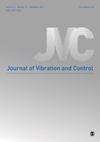A composite motion control method for quadruped robots in trot gait
IF 2.4
3区 工程技术
Q2 ACOUSTICS
引用次数: 0
Abstract
This work aims to address the issues of instability in trot gait walking and poor terrain adaptability in rugged environments under conventional control strategies for quadruped robots by proposing a novel composite control strategy. During the support phase, a separated force-position mixing control method is employed, utilizing gravity-compensated PD (Proportional Derivative) control at the lateral swing and knee joints while employing position control at the hip joint. During the swing phase, VMC (Virtual Model Control) is used to construct three sets of virtual spring-damper components, guiding the foot to move along a predetermined trajectory and converting virtual forces into joint torques for the swinging leg. At the body, IMU (Inertial Measurement Unit) feedback data combined with PI (Proportional Integral) control is used to adjust leg length and maintain the robot’s posture stability. Finally, the proposed separated force-position hybrid control method is theoretically validated using the Lyapunov stability criterion, and simulation tests on flat and rugged terrains under the quadruped robot’s composite control method are conducted using MATLAB/Simulink, comparing it with the VMC and position control methods. The findings indicate that the composite control strategy leads to smaller changes in the attitude angles and reduced impact forces at the feet during the quadruped robot’s walk on flat ground while also demonstrating strong adaptability to rugged terrains.四足机器人小跑步态复合运动控制方法
本研究旨在通过提出一种新型复合控制策略,解决四足机器人在传统控制策略下小步行走不稳定和在崎岖环境中地形适应性差的问题。在支撑阶段,采用分离式力-位置混合控制方法,在侧摆和膝关节处利用重力补偿 PD(比例偏差)控制,同时在髋关节处采用位置控制。在摆动阶段,VMC(虚拟模型控制)用于构建三组虚拟弹簧减震组件,引导脚沿着预定轨迹移动,并将虚拟力转换为摆动腿的关节扭矩。在机身上,IMU(惯性测量单元)反馈数据与 PI(比例积分)控制相结合,用于调整腿的长度并保持机器人的姿态稳定。最后,利用 Lyapunov 稳定性准则对所提出的力-位置分离式混合控制方法进行了理论验证,并使用 MATLAB/Simulink 对四足机器人的复合控制方法在平坦和崎岖地形上进行了仿真测试,将其与 VMC 和位置控制方法进行了比较。结果表明,四足机器人在平地行走时,复合控制策略导致姿态角变化较小,脚部受到的冲击力减小,同时对崎岖地形也表现出很强的适应性。
本文章由计算机程序翻译,如有差异,请以英文原文为准。
求助全文
约1分钟内获得全文
求助全文
来源期刊

Journal of Vibration and Control
工程技术-工程:机械
CiteScore
5.20
自引率
17.90%
发文量
336
审稿时长
6 months
期刊介绍:
The Journal of Vibration and Control is a peer-reviewed journal of analytical, computational and experimental studies of vibration phenomena and their control. The scope encompasses all linear and nonlinear vibration phenomena and covers topics such as: vibration and control of structures and machinery, signal analysis, aeroelasticity, neural networks, structural control and acoustics, noise and noise control, waves in solids and fluids and shock waves.
 求助内容:
求助内容: 应助结果提醒方式:
应助结果提醒方式:


